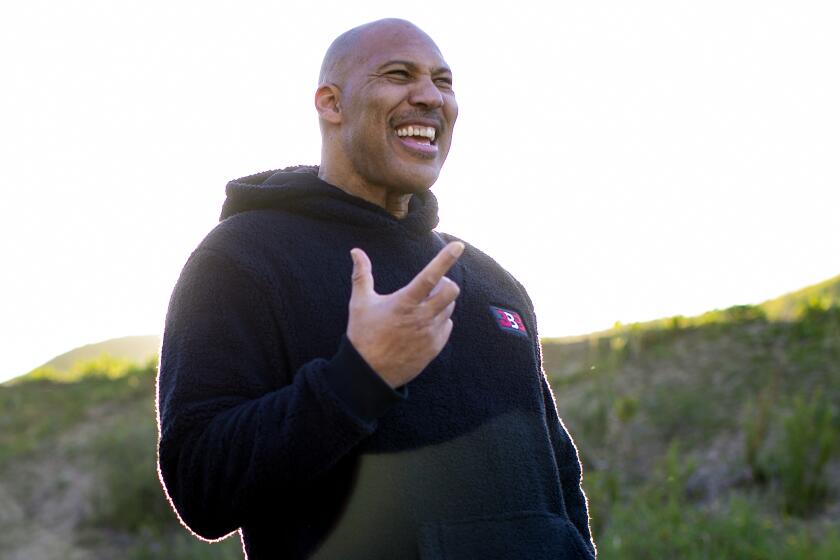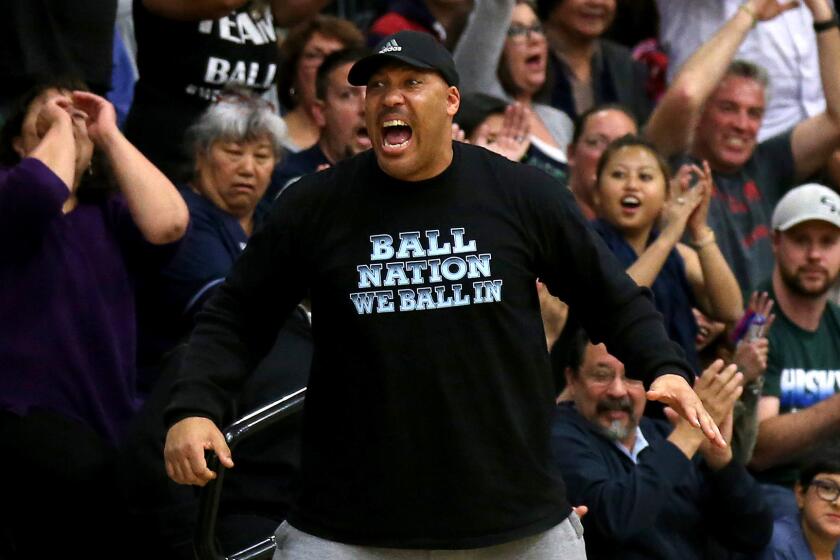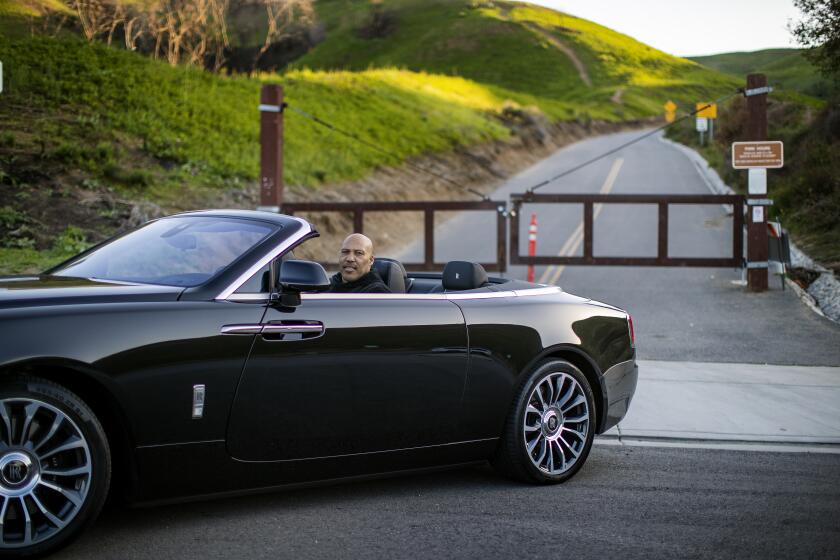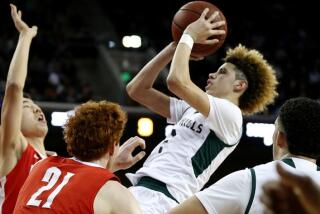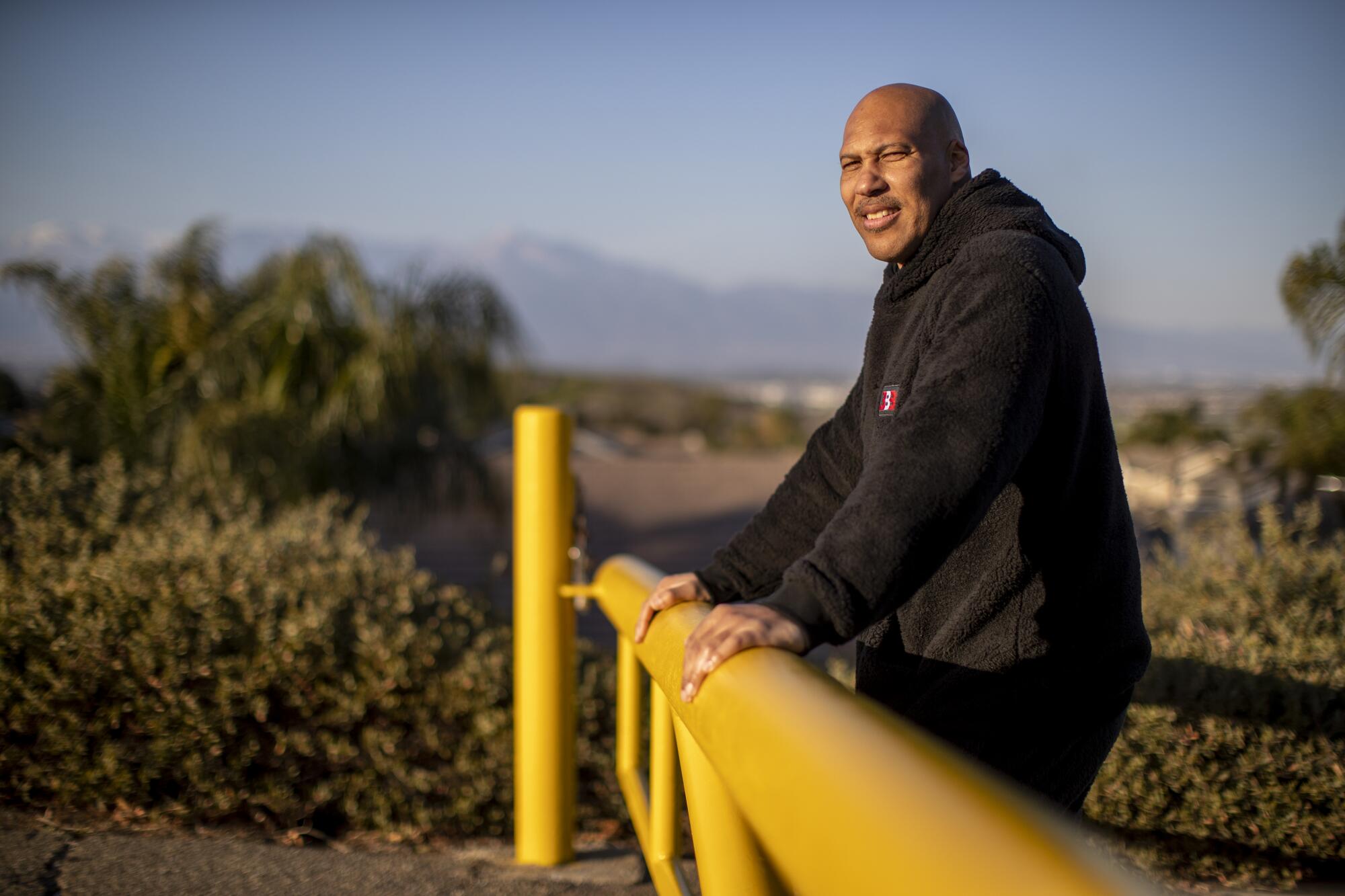
- Share via
The lucky few hikers who found a parking spot along Elinvar Drive on a recent morning pulled on down jackets against a biting wind and headed uphill, forming a steady line. Not one who passed through the bustling north entrance of Chino Hills State Park dared to veer from Bane Canyon Road to go up the dirt path on the left side, the one snaking up the ridgeline at an incline steep enough that the trail eventually disappeared from view.
When LaVar Ball first saw this stretch of dirt, the difficulty of reaching the top was less daunting than it was intriguing. He brought his three sons to the trailhead and had them run all the way up. The faster they climbed here, he said, the easier they’d fly down the basketball court.
It was a fitting training ground. These hillsides were the first thing Ball noticed in 1996 when he and his wife, Tina, moved to Chino Hills. That and the distance from South L.A., where he’d grown up.
When she picked him up at Los Angeles International Airport to show him the house they’d discussed buying while he was spending part of the 1995 NFL season on the Carolina Panthers’ practice squad, the drive east through suburbia took three hours in weekday traffic.
“I said, ‘Why in the hell did you move us way out here?’” Ball said. “I was like, “Oh my god.”
The first time his parents visited, and asked where the mooing sound was coming from, LaVar pointed to a herd grazing a nearby hillside. The plan had been to move to West Covina. But the new city quickly grew on him. From here, he told anyone who would listen that Lonzo, LiAngelo and LaMelo would become outliers, and not only in a geographic sense.
LaVar Ball moved to Chino Hills nearly 25 years ago to start a family with wife Tina.
Paul Spitzzeri, a museum director who knew LaVar from a local gym, and who came from a basketball coaching background, visited the Balls’ house when Lonzo and LiAngelo were only a few years old.
“[LaVar] said, ‘Yeah these two are going to be in the NBA,’” Spitzzeri recalled. “I just looked at him like, well, that’s interesting that you have that goal already and they’re only toddlers.”
LaVar was clear about one thing: “I told people back in the day I was going to put us on the map and people thought it was like, he just talking. I was like, man, Chino Hills going to be known for the Balls. Guaranteed.”
Five years after the brothers turned that prediction into reality, rising to national prominence by running Chino Hills High’s opponents off the court en route to an undefeated state championship —all while their father’s soundbites made him one of basketball’s most talked-about figures — the Balls and the city remain as intertwined as ever.
An in-depth look at the fascinating relationship between LaVar Balll and his family with the city of Chino Hills.
When the NBA season began in December with all three brothers on training camp rosters, their father remained in the family’s estate, tucked atop one of the city’s canyons, planning what he says will be a next act that will plunge the family’s roots even deeper into this affluent bedroom community of 82,000 in San Bernardino County’s southwest corner.
“When you hear that Ball name, just like you hear the Hiltons and the Rockefellers and all that, when I’m dead and gone, you going to remember that Ball name,” he said.
Predicting the level of championship success his sons attained as prep teammates, he says he has spent this NBA season trying to tell Michael Jordan, the NBA icon-turned-owner of the Charlotte Hornets, who drafted LaMelo third overall in November, to add all three brothers to their roster. He is no less bullish on his resolute vision to build a self-described empire worth $1 billion, saying the presence of the family’s Big Baller Brand, which currently moves its apparel, hot sauce and shoes online, could be felt locally soon, eyeing potential plans to buy storefronts, build a basketball training facility and sell rims, tires and bottled water.
“I didn’t get some money and then be like, oh, you know what? Let’s move to Beverly Hills, baby, we’re going to Palisades, we’re going to the city,” LaVar said. “Stayed right here. And every time somebody in Chino Hills look and see a nice-ass car, guess who’s in it? Me or my boys. It’s crazy.”
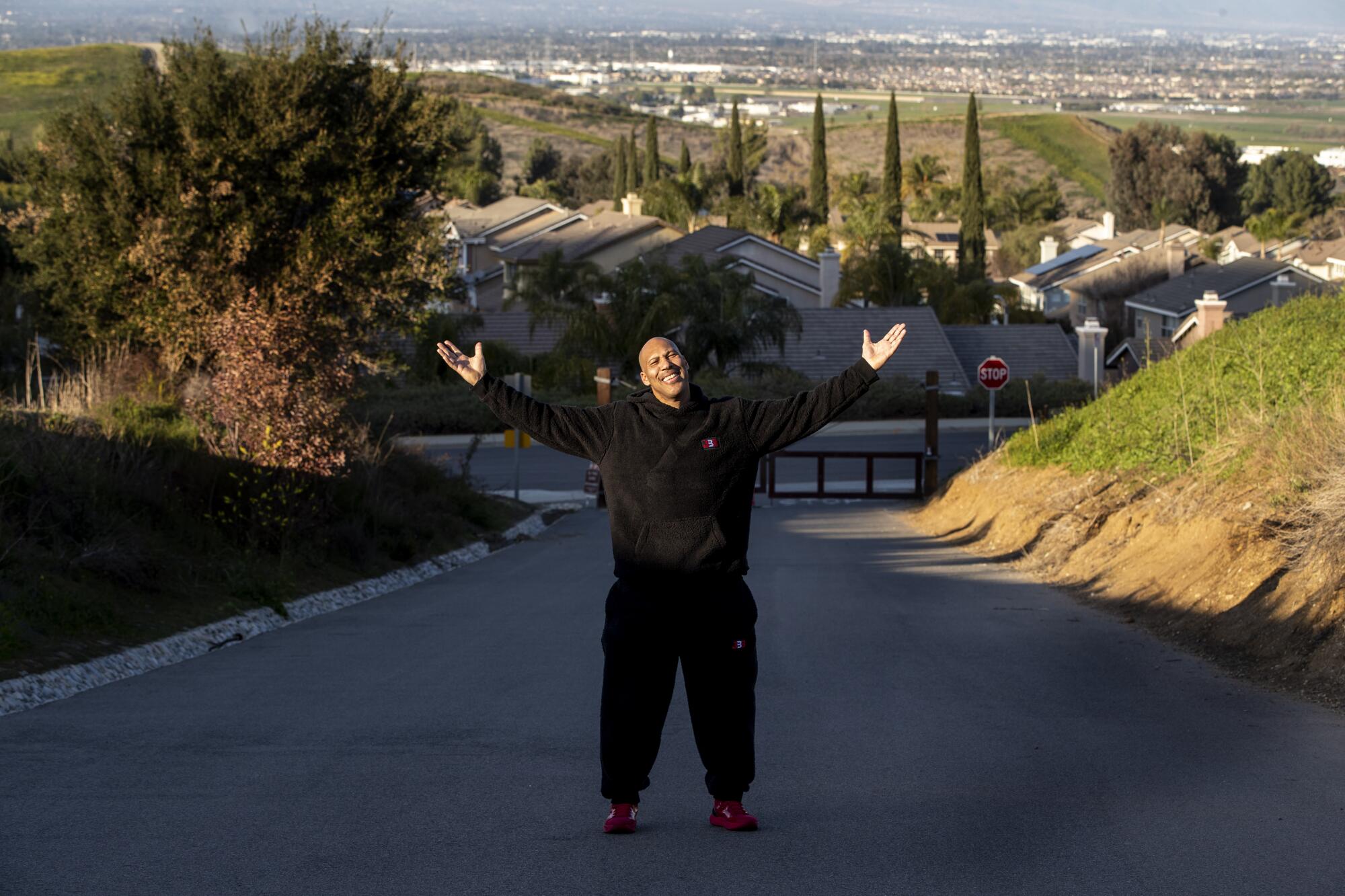
He’s been called that before here, where not everyone has embraced LaVar’s bombastic promotion. At the height of the spectacle following the high school’s 2015-16 championship season, said Peter Rogers, a city councilman and former mayor who moved here in 1986, “sometimes we’d have to push back on [LaVar] when we see him because he’d walk around, ‘I’m the mayor of Chino Hills!’”
“I didn’t get some money and then be like, oh, you know what? Let’s move to Beverly Hills, baby, we’re going to Palisades, we’re going to the city. Stayed right here.”
— LaVar Ball
But even after LaMelo was pulled out of Chino Hills High after his sophomore season to begin a globe-trotting professional tour, his return to Los Angeles this week for his first NBA games at Staples Center has been received with full-throated support by a hometown whose own backstory mirrors that of its highest-profile family. For all of the surface differences between LaVar and this quiet slice of suburbia, the city’s striving ambition to emerge from nothing in less than three decades is not dissimilar to the way LaVar famously talks of speaking his goals into existence.
“They’ve become a kind of fabric of our community in a way,” Rogers said. “They’re going to be in Chino Hills forever, possibly.”
::
In 1926, before dropping into the Inland Empire basin, drivers heading east on the newly paved Carbon Canyon Road first stopped at Los Serranos Country Club. The golf club had opened only the year before, surrounded by a subdivision in the hills above Chino.
A few miles north sat the 200-acre campus for what became Boys Republic, a residential facility for wayward teenagers. Steve McQueen lived there in the 1940s before becoming a silver screen celebrity an hour west in Hollywood.
For the next five decades, the rolling hills in between largely remained undisturbed grazing land. That changed in 1979. With the suburbs to the east and north growing as would-be homeowners left Los Angeles and Orange counties for less expensive real estate, San Bernardino County approved a master plan covering 18,000 acres of one of its last undeveloped pockets. Neighborhoods were laid out along the ridges in the villages style popularized in Irvine. One, Gordon Ranch, produced the multi-generation Gordon racing family.
“They had seen a lot of other parts of the region grow up and so they had the chance to decide if they wanted to be unique in a particular way,” said John Husing, a regional economist who has studied the Inland Empire since 1964. “It was a plan with ambition but they also lucked out with geography.”
That ambition continued after residents approved incorporation in 1991, a push partly rooted in a desire to separate its identity from neighboring Chino, which was known for its men’s prison and dairies, said Spitzzeri, who writes a history blog about Chino Hills’ Carbon Canyon. While outsiders remember Chino Hills for the dairies’ smell that wafted over on the Santa Ana winds, the city’s planners — like Ball would later, about his sons — envisioned something grander: a landing spot for professionals and families who didn’t want to stray too far east from the coastal counties but desired safety, good schools and a high-end feel for less money.

“That’s what they wanted,” said Husing, whose Economics & Politics firm once drafted the city’s economic strategy. “They got it.”
One family drawn by that promise was the Okongwus, who moved from Hawthorne when their second-oldest son, Onyeka, was 7. He quickly met a curly haired basketball player named LaMelo Ball. They watched from the stands as Lonzo’s and LiAngelo’s high-scoring exploits quickly spread the high school’s name recognition across social media. At the local 24 Hour Fitness, word quickly spread when the Ball brothers showed up to play pickup games.
“That team evolved the whole city into something else, like a mini-basketball town,” Okongwu said.
Growing up in Chino, Christian Rivas’ first inkling of the burgeoning sensation in the neighboring city hit him in high school, while talking to a street performer on the Las Vegas strip.
“He asks me, ‘Where are you from?’ and I said ‘Chino,’” said Rivas, a producer with SB Nation who has written about the city. “He goes, ‘Chino Hills, do you know Lonzo, LaVar all them?’”
By LaMelo‘s and Okongwu’s freshman season, Rogers and Rivas were waiting in line to get a seat in a standing room-only gym. Television networks wanted to broadcast games. The Huskies scored 100 or more points 18 times on their way to a 35-0 record and state title. By producing three future top-10 NBA draft picks in Lonzo, LaMelo — the first brothers to be selected in the top five — and Okongwu, and two Division I recruits in LiAngelo and Eli Scott, the team is in the conversation for one of the greatest in prep history, some NBA scouts say.
It was certainly, at least, one of the most visible.
“You couldn’t replicate that in too many places,” Spitzzeri said.

The following season, with Lonzo at UCLA and a new head coach at Chino Hills, the spotlight burned hotter as LaMelo scored 92 points.
“A crazy game,” Okongwu said. “It was just wild.”
In many ways, however, the real show was LaVar, who took selfies with opposing fans and became a regular on national sports talk shows by making pronouncements, including one that Lonzo would be better than Magic Johnson. At 6-foot-6, LaVar could draw as much attention at games as the alley-oops and full-court passes, Rivas said, “like seeing the circus in town.” People told him they’d moved to Chino Hills because of his family, LaVar said.
Rogers believed residents eventually got used to his often outlandish TV presence while also seeing the dad who’d pull up to a stoplight and talk to people in the next car over.
“There wasn’t any tension as far as I’m concerned,” Rogers said. “It was a controlled circus, but it was a cool kind of circus that was going on around town. I don’t think there was any regret that this was happening because it was people coming out to sports, to watch sports. All of a sudden there they are in the national spotlight.”
LaVar had predicted this after he and Tina arrived. In the suburbs, he saw a chance for his kids to grow up comfortably with plenty of future opponents unprepared for the Balls’ uptempo style.
“That’s why my boys are so good, because they like camouflage,” LaVar said. “They raised in Chino Hills but they had my mental attitude, which is the South Central tough-type. … They real mean but they don’t look mean because they from Chino Hills.”
The city had designed itself to draw families.
Now it was home to one of American sports’ most well-known and polarizing.
::
By early 2018, Lonzo remained in Southern California as the rookie point guard of the Lakers, the landing spot his father had once brashly predicted. To keep up with his younger brothers, though, friends back home had to watch the family’s Facebook Watch reality show, “Ball In The Family.”
LaMelo, just 16, and LiAngelo were in Lithuania, with pro contracts. A few months before, LaMelo began home-schooling after LaVar went public with frustrations with Chino Hills’ new coach. Weeks later, after UCLA suspended LiAngelo after he and two other teammates were detained on suspicion of shoplifting during a team trip to China, LaVar pulled him out of UCLA. LaMelo’s teenage odyssey eventually took him to an Ohio prep school for his senior season, then to a pro team in Australia where he played 12 games before injuring a foot.
They eventually returned to a hometown last spring that had lived up to its planners’ hopes. It has the second-highest median income in the Inland Empire, and more than 62% of residents hold an associate’s degree or higher — double that of the Inland Empire, Husing said. Boys Republic’s entrance now sits across a parking lot from an outdoor mall, where diners at outdoor tables munched on sushi.
The conditions that fueled that growth have changed. The median home price in Chino Hills was $690,300 in 2019, according to census data, higher than L.A. County and only slightly lower than in Orange. The city’s 45 parks, 48 miles of trails and 3,000 acres of public open space, which the city says it will not develop, have added to its desirability. The population has doubled in 30 years, and city leaders say it is difficult to plan for the new home construction the state has mandated.
When the homeowners association surrounding the Greg Norman-designed Vellano Golf Course rejected plans by course owners to build between 132 and 174 homes on the property, the course promptly shut down in 2018.
“That’s probably our biggest struggle right now is where to put 3,700 homes that have been deemed that Chino Hills has to put in or at least allow to put in,” Rogers said.
The city’s planning commission recently approved the Balls to build an indoor practice facility on their home’s property, said commission member Patrick Hamamoto, but LaVar could be in the market for more land that could turn the Ball effect into a more public brick-and-mortar presence. He says he wants to build a training facility, perhaps with 12 courts, to draw the kind of Amateur Athletic Union tournaments to Chino Hills the Balls used to have to travel to compete in. He envisions creating jobs by buying restaurant spaces.
It is one of the projects LaVar says he will discuss with his sons after the season is over. With New Orleans, Lonzo is amid the best statistical season of his four-year career. With Charlotte, LaMelo is a highlight machine and was frontrunner for rookie of the year until a wrist injury sidelined him likely for the rest of the season. If they pool the family’s resources to increase their holdings, he can decrease the need for outside investors. By spring, LaVar says Big Baller Brand water, bottled in Hawaii, will be on grocery shelves. By summer, he expects to sell triple-B-branded tires and three-piece rims. “Ball In The Family” ended after six seasons — because, he said, he might instead produce the show.
He has made pronouncements of multi-billion-dollar evaluations before, insisting major apparel conglomerates would need to license his brand name, but such partnerships never materialized. In 2019, Lonzo and Big Baller Brand accused the company’s cofounder of taking more than $1.5 million from the company’s accounts. The co-founder, Alan Foster, who had known Lonzo for years, countersued. Lonzo has worn Nikes since and LaMelo has a shoe contract with Puma.
LaVar Ball and his basketball-playing sons helped put Chino Hills on the map. He talks about their success, their future and why they chose to stay.
“It’s a family brand, that’s why I say my boys ain’t going nowhere just because they doing some other things with Puma and whoever they doing it with,” he said. “They still with Big Baller Brand because it’s a family brand, and that’s what people don’t understand.
“They like to say, ‘Oh, no, Melo left and Melo did this, Lonzo ain’t talk to his dad no more, he did this,’ No. I talk to my boys every day and it’s all good. We don’t have to show out on the outside and people looking in.”
The sons could have moved on from their hometown as they grew older. Instead they spent the last offseason mostly in the same neighborhood. Rogers said it wasn’t uncommon to see LaVar, LiAngelo and LaMelo “out training at our local parks and out running around” during the early months of the pandemic last spring. In May, the sons took part in a peaceful protest in the city following the death of George Floyd. Okongwu says the ties are simple: LaMelo loves his family and his family loves Chino Hills.
“They’ll always have roots there,” Okongwu said.
“The relationship with the city ultimately boils down to the pride they have in coming from the city,” said Rivas, who now lives in Chino Hills. “Without that, I don’t know if anyone would be rooting for them because you hear of people from Chino that do go on to do things and it’s almost as if they forget that they came from this small town. They like to slap on that ‘L.A.’ label — anyone from Southern California is from Los Angeles.
“... The fact that they are genuinely proud and happy to be from Chino Hills, will rep it every chance they get, I think is a big reason why people are genuinely enthused to be rooting for them.”
The fact that they are genuinely proud and happy to be from Chino Hills, I think is a big reason why people are genuinely enthused to be rooting for them.”
— Christian Rivas
Last November, NBA teams wanting one last look at LaMelo traveled to a converted Ralphs market off Chino Hills Parkway. The clientele of 3-Point Play Zone, a two-court basketball training center, is mostly kids and families who walk through an entrance lined with quotes by Kevin Durant and LeBron James. To Tyler Gamblin, its program director who has known LaMelo since he was 8, it was no surprise LaMelo held his predraft workout there.
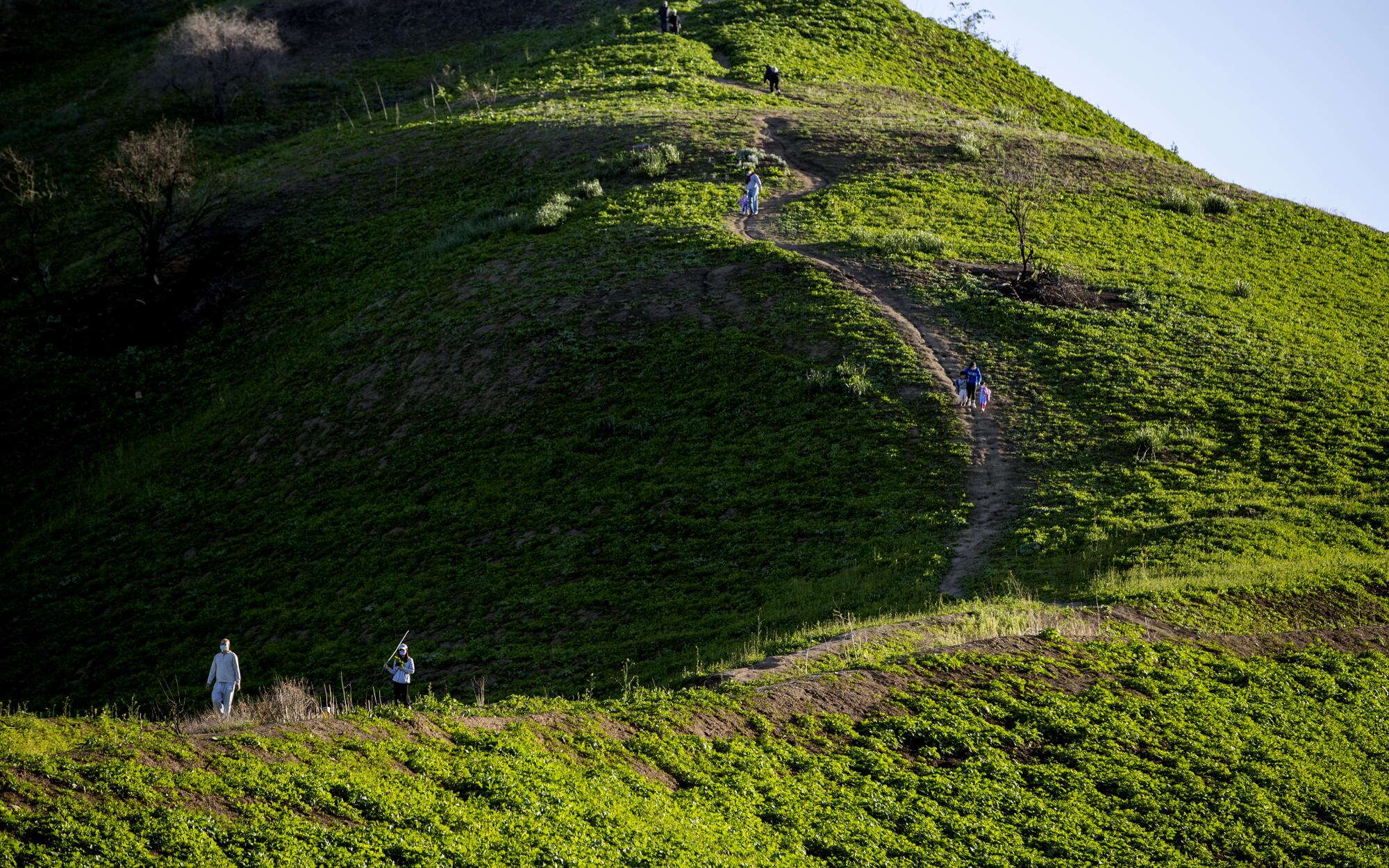
The brothers are loyal to the city, he said. In turn he’s seen their effect take hold around town, where “sports in general has taken on a new hype with them going to the NBA,” Gamblin said. “They’re trying to be the next Ball family.”
As LaMelo worked out, shooting behind an NBA-distance three-point arc added for the occasion, Golden State coach Steve Kerr, Charlotte general manager Mitch Kupchak and Detroit coach Dwane Casey were among the attendees. LaVar wasn’t there, saying he didn’t need to be reminded of talent he has always believed in. He had other matters to tend to.
His feet remain planted in Chino Hills. Undaunted by its difficulty, he sees another path to the top awaiting the family.
“They’re going to say, man, this guy created this empire and it started in a backyard in Chino Hills,” LaVar said. “And that’s the story line.”
More to Read
Go beyond the scoreboard
Get the latest on L.A.'s teams in the daily Sports Report newsletter.
You may occasionally receive promotional content from the Los Angeles Times.

